“A man can believe, and make his own, in the most genuine way, what he has received from another;–and with boundless gratitude to the other. The merit of originality is not novelty; it is sincerity. The believing man is the original man; whatsoever he believes, he believes it for himself, not for another.”
Thomas Carlyle, “The Hero as Priest”
Archives for February 2012
HOW CAN SKEPTICS MAKE GREAT RELIGIOUS ART?
“Most of the modern novelists who have placed matters of faith at the center of their work have been, like Graham Greene, C.S. Lewis, François Mauriac and Flannery O’Connor, believers of one sort or another. But in every other branch of art, great works of devotional art have been created by skeptics, not a few of whom were fire-breathingly militant about their doubt…”
TT: Still angry after all these years
Today’s Wall Street Journal drama column is devoted in its entirety to the Roundabout Theatre Company’s revival of Look Back in Anger. Here’s an excerpt.
* * *
It’s disorienting to watch the film version of John Osborne’s “Look Back in Anger” fifty-six years after the play on which it was based exploded onto the London stage. The history books assure us that Mr. Osborne swept away the genteel, well-made drawing-room comedies that had long dominated British theater, replacing them with blunt expressions of pent-up rage against the class machine. Yet the first thing you see on screen is an all-white, banjo-powered Dixieland band, for New Orleans-style jazz was the preferred music of England’s “angry young men,” as Mr. Osborne and his fellow rebels soon came to be known, back in the benighted days before the arrival of John, Paul, George and Ringo.
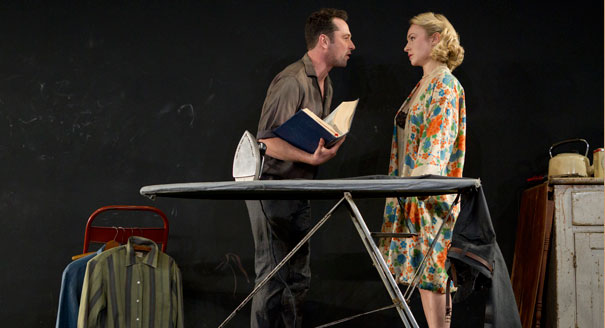 That’s how dated “Look Back in Anger” is, and that’s why it’s surprising that the Roundabout Theatre Company’s new revival, staged with flame-throwing éclat by Sam Gold, should be so theatrically potent. For not only is Mr. Osborne’s first play a period piece, but it is an ultra-British period piece, one whose author, not surprisingly, failed to make a lasting impression on American theatergoers. No play of his has been seen on Broadway since 1969. Indeed, “Look Back in Anger” is being mounted at the Laura Pels Theatre rather than in one of the company’s Broadway houses, which suggests a certain lack of confidence about its prospects at the box office.
That’s how dated “Look Back in Anger” is, and that’s why it’s surprising that the Roundabout Theatre Company’s new revival, staged with flame-throwing éclat by Sam Gold, should be so theatrically potent. For not only is Mr. Osborne’s first play a period piece, but it is an ultra-British period piece, one whose author, not surprisingly, failed to make a lasting impression on American theatergoers. No play of his has been seen on Broadway since 1969. Indeed, “Look Back in Anger” is being mounted at the Laura Pels Theatre rather than in one of the company’s Broadway houses, which suggests a certain lack of confidence about its prospects at the box office.
This lack of confidence is understandable, since “Look Back in Anger” is culture-specific and time-bound in a way that presents real problems of understanding to Americans, especially those under 50, who know little of what England was like in 1956. But an effective production can overcome at least some of these problems, and this one is up to the mark, not least because Mr. Gold has fielded a top-of-the-line cast led by Matthew Rhys, who is so exciting as Jimmy Porter, Mr. Osborne’s anti-hero and alter ego, that you’ll likely be inclined to take his self-lacerating anger for granted rather than trying to puzzle out its source…
I suspect that the first half of “Look Back in Anger” is too deeply rooted in its time and place ever to be fully intelligible to the ordinary American theatergoer. If, on the other hand, you’re capable of making sense of such postwar English novels as, say, Kingsley Amis’ “Lucky Jim,” then you’ll have a pretty good idea of what’s going on, and Mr. Gold’s direction is so passionately precise that it contrives to make most of the rough places plain enough….
* * *
Read the whole thing here.
The opening scene of the 1958 film version of Look Back in Anger:
TT: Agnostics in paradise
In today’s Wall Street Journal “Sightings” column, inspired by a scene in the Roundabout Theatre Company’s revival of Look Back in Anger, I consider the seeming paradox of religious art created by skeptics. Here’s an excerpt.
* * *
Rarely have I seen a spectacle so disheartening as the cheerless, trash-strewn one-room flat that serves as the set for the Roundabout Theatre Company’s Off-Broadway revival of John Osborne’s “Look Back in Anger.” In this production, reviewed elsewhere in today’s Journal, the only hint of beauty comes from the radio on which the play’s unhappy characters listen to Ralph Vaughan Williams’ radiant Fifth Symphony. Small wonder that it should offer them a glimpse of comfort and joy in the midst of their emotional turmoil. Like so much of Vaughan Williams’ music, the Fifth Symphony, which was composed during World War II, is deeply spiritual in tone, and it’s no surprise to learn that it was based on themes from his operatic version of “The Pilgrim’s Progress.”
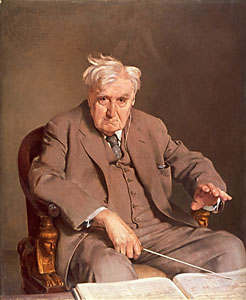 Here’s the surprise: Vaughan Williams was a lifelong agnostic.
Here’s the surprise: Vaughan Williams was a lifelong agnostic.
Now that the boutique atheism of such aggressive secularists as Richard Dawkins, Sam Harris and Christopher Hitchens has become chic, you might well find yourself wondering why any unbelieving artist would bother to turn his hand to the making of religious art. Indeed, most of the modern novelists who have placed matters of faith at the center of their work have been, like Graham Greene, C.S. Lewis, François Mauriac and Flannery O’Connor, believers of one sort or another. But in every other branch of art, great works of devotional art have been created by skeptics, not a few of whom were fire-breathingly militant about their doubt….
How can such folk take up their tools in the name of God–and why would they want to do so? If you’re a person of faith, the answer is obvious: They are guided by divine grace, which theologians assure us can be perceived partially or not at all. But there are other explanations….
* * *
Read the whole thing here.
Sir Adrian Boult conducts the London Philharmonic in the first movement of Vaughan Williams’ Fifth Symphony:
TT: Nice guy
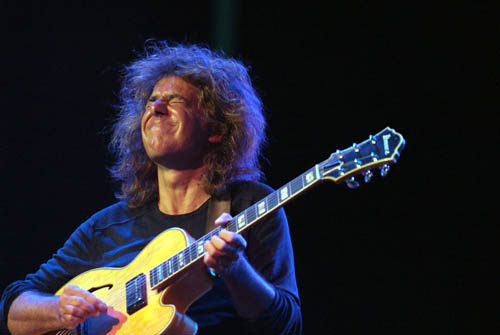 In addition to being a great artist, Pat Metheny is also a very nice person. If you work in the arts, you’ll know that these two things don’t always go hand in hand. Because we both grew up in Missouri, I know that Pat’s warm smile and unselfconscious sweetness of character, like the spacious, wide-open sound of his music, are deeply rooted in the friendly place where he was born and raised. It is, sad to say, quite possible for an unfriendly person to make beautiful music, but I like to think that the existence of such sour folk is an insult to the natural order of things. If so, then Pat Metheny makes up for Stan Getz or Benny Goodman.
In addition to being a great artist, Pat Metheny is also a very nice person. If you work in the arts, you’ll know that these two things don’t always go hand in hand. Because we both grew up in Missouri, I know that Pat’s warm smile and unselfconscious sweetness of character, like the spacious, wide-open sound of his music, are deeply rooted in the friendly place where he was born and raised. It is, sad to say, quite possible for an unfriendly person to make beautiful music, but I like to think that the existence of such sour folk is an insult to the natural order of things. If so, then Pat Metheny makes up for Stan Getz or Benny Goodman.
As I recently mentioned in this space, Pat came to Winter Park the other day to spend some time at Rollins College, my academic home away from home, and he and I made two joint appearances during his brief stay. On Wednesday Chuck Archard and I interviewed him in front of an audience, and on Thursday I moderated a question-and-answer session that followed a concert by Pat and Larry Grenadier, the bassist with whom he’s spent the past few months barnstorming all over the world.
Pat flew directly from Japan to Florida on Tuesday. The mere fact that he managed to show up for Wednesday’s session was thus more than a little bit astonishing. To say that he was exhausted is an understatement–his eyes were completely bloodshot–and I wouldn’t have been at all surprised if he’d cut the evening short. Instead he let it run well into overtime, taking innumerable questions from the audience and answering them with the unfailingly courteous aplomb for which he is legendary among journalists.
I doubt you’ll be entirely surprised to learn that not all non-verbal artists are at home in the world of words. I’ve written profiles of one or two well-known musicians who simply couldn’t talk at all, thus forcing me to jump through hoops in order to create the illusion that they had something to say. Fortunately, Pat talks as well as he plays, and “interviewing” him is simply a matter of asking an occasional leading question, then scurrying out of the way. Everything he said on Wednesday was quotable, so much so that I’m planning to transform our chat into one of the Saturday Wall Street Journal‘s “cultural conversations” at some point in the next month or two. I guarantee that it’ll be worth reading, and I can assure you that I won’t deserve the least bit of credit for its readability.
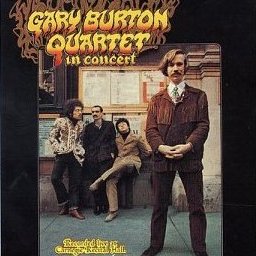 Midway through the evening, Pat praised my Louis Armstrong biography in a way that made me blush. I knew that he’d liked Pops, but to hear him say so in public was…well, let’s just say that I’ll treasure the memory as long as I live. As if that weren’t enough of a thrill for one evening, Larry Coryell, Pat’s illustrious predecessor in the legendary Gary Burton Quartet, happened to be in the audience on Wednesday. I couldn’t believe my eyes when he raised his hand to ask Pat a question about harmony. It was as if William Faulkner were quizzing Flannery O’Connor.
Midway through the evening, Pat praised my Louis Armstrong biography in a way that made me blush. I knew that he’d liked Pops, but to hear him say so in public was…well, let’s just say that I’ll treasure the memory as long as I live. As if that weren’t enough of a thrill for one evening, Larry Coryell, Pat’s illustrious predecessor in the legendary Gary Burton Quartet, happened to be in the audience on Wednesday. I couldn’t believe my eyes when he raised his hand to ask Pat a question about harmony. It was as if William Faulkner were quizzing Flannery O’Connor.
Thursday’s performance and post-concert colloquy were, if anything, even more exciting, and Larry turned out to be every bit as articulate as Pat. Mrs. T, who’d never heard Pat other than on record, was transported. Midway through “Change of Heart,” she leaned over to me and said, “They’re not here, are they? They’re in the music.” So they were–and so were we.
* * *
Gary Burton, Pat Metheny, Steve Swallow, and Antonio Sanchez play Metheny’s “B & G (Midwestern Night’s Dream)”:
TT: The Eames films (V)
This week I’m posting five films made by Charles and Ray Eames. Today’s installment, Powers of Ten, was made in 1968:
TT: Almanac
“Fashion is custom in the guise of departure from custom.”
Edward Sapir, Fashion
TT: Closing time
The Oak Room of the Algonquin Hotel is no more. According to published reports, it will now become “a lounge for Marriott Reward Elite guests.” The next time you consider staying at a Marriott hotel, remember who committed that act of cultural vandalism.
I published a tribute to the Oak Room a few years ago in which I summed up how I felt about one of the places that made New York New York. Here’s part of it.
* * *
Eighty well-dressed people sit silently in a darkened, oak-paneled room in the center of Manhattan. Some have plates of food in front of them, others have drinks at their elbows, but nobody is paying much attention to food or drink right now, not even the waiters. Instead, they’re all listening to a woman seated on a high stool placed in the bend of a piano, her handsome face lit by a single baby spotlight. Her name is Weslia Whitfield, and she’s singing a song everyone here knows by heart: Somewhere over the rainbow/Bluebirds fly/Birds fly over the rainbow/Why then oh why can’t I? It takes a lot of nerve, and a lot of talent, to sing a song like that in a room like this. The woman has both, which is why the crowd is so quiet: you could hear a pin drop across the street.
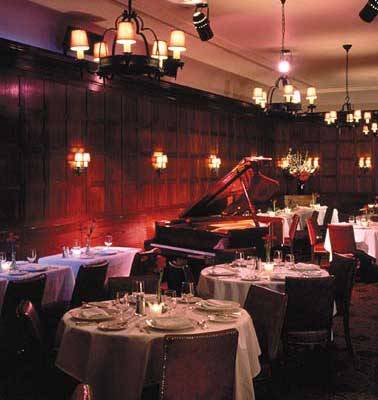 The song ends, and the crowd cheers–decorously (for this is a decorous room), but nonetheless enthusiastically. As the applause swells and the waiters start stalking through the room once more, Weslia Whitfield grins her crinkly-eyed, I’m-having-fun grin and nods her head in acknowledgment of the hubbub. She knows what she just did: she stopped the show in the Oak Room of New York’s Algonquin Hotel. For a cabaret singer, life doesn’t get much better than this.
The song ends, and the crowd cheers–decorously (for this is a decorous room), but nonetheless enthusiastically. As the applause swells and the waiters start stalking through the room once more, Weslia Whitfield grins her crinkly-eyed, I’m-having-fun grin and nods her head in acknowledgment of the hubbub. She knows what she just did: she stopped the show in the Oak Room of New York’s Algonquin Hotel. For a cabaret singer, life doesn’t get much better than this.
One of the first things I did after I moved to New York City was have dinner at the Algonquin with a group of friends, budding writers all. We sat at a round table in the Rose Room and gazed longingly across the room at another round table–the round table, to be exact. We didn’t say anything about it, because we didn’t have to; we’d all read the same books in high school and college, and dreamed the same dreams. Instead of pointing and gawking, we swapped wisecracks, pretending they were as clever as the ones George S. Kaufman and Dorothy Parker fired off right over there. I kept thinking of the scene in the movie Laura in which the beautiful Gene Tierney accosts the waspish Clifton Webb at lunchtime: it was filmed here. No doubt everyone else at our table, if not the whole room, was thinking roughly similar thoughts. The Algonquin does that to you….
The Algonquin Hotel is still doing business at the same old stand, 59 W. 44th St., just about halfway between Broadway and Grand Central Station. Needless to say, the Round Table is no longer in operation, and more than a few of its once-renowned members are long forgotten. (When did Franklin P. Adams’ name last cross your mind?) But in a city that prides itself on change, the Algonquin prides itself on not changing, and if Noël Coward, Harpo Marx, or William Shawn were to stroll through the front door tomorrow morning, they’d know just where they were. The lobby still has the comfortable air of a slightly down-at-heel men’s club–you ring a brass bell to summon a waiter–and Matilda, the current Algonquin cat, still has free run of the place. Fancy it isn’t; classy it most decidedly is.
A very large part of what makes the Algonquin so classy is what goes on in the Oak Room at night. During the day, it’s a well-lit place to eat lunch, complete with canned music; after dark, it’s New York’s most prestigious supper club, the place where every singer in America who prefers Cole Porter to MTV Unplugged dreams of working. Back in 1939, Frank Case, who ran the hotel throughout its Round Table days, turned the Oak Room into a nightclub whose regular patrons included the likes of Tallulah Bankhead, Greta Garbo, and Hedy Lamarr. But World War II put an end to cabaret at the Algonquin, and it wasn’t until 1981 that the Oak Room again became a venue for American popular song. The singer-pianist Steve Ross, hired on a trial basis, stayed there for four years, and the Algonquin has been presenting cabaret acts ever since….
 What makes the Oak Room so special? Obviously, the singers who perform there are the heart of the matter, though the room itself contributes significantly to the effect they make. Cabaret is an intimate art, and the eighty-seat Oak Room, with its amber sconces and red velvet banquettes, is as up close and personal as a love seat at midnight: there is no finer place to listen to songs of passion and despair. “It’s nice singing in a room this small,” Whitfield says, “because I get feedback from the people. I know what works–and what doesn’t work. When they’re bored, you can hear them scrunching up their toes in their shoes. You can get that kind of response in a larger room, but it’s very slow, and very limited.”
What makes the Oak Room so special? Obviously, the singers who perform there are the heart of the matter, though the room itself contributes significantly to the effect they make. Cabaret is an intimate art, and the eighty-seat Oak Room, with its amber sconces and red velvet banquettes, is as up close and personal as a love seat at midnight: there is no finer place to listen to songs of passion and despair. “It’s nice singing in a room this small,” Whitfield says, “because I get feedback from the people. I know what works–and what doesn’t work. When they’re bored, you can hear them scrunching up their toes in their shoes. You can get that kind of response in a larger room, but it’s very slow, and very limited.”
But the Oak Room’s not-so-secret ingredient, irreproducible at any price, is the fact that it is part and parcel of the Algonquin Hotel. “Lots of famous people slept at the Waldorf,” an old Algonquin hand says sniffishly, “but nobody did anything there.” Well, plenty of people did things at the Algonquin, and not just the members of the Round Table, either. William Faulkner wrote his Nobel Prize acceptance speech there; the New Yorker was practically invented there. Sinclair Lewis actually offered to buy the place. Everybody who sings in the Oak Room knows it isn’t just another club: it’s a piece of history. “There are ghosts here,” says Weslia Whitfield. “But good ghosts. They want you to do well.”
It struck me the other day that America had finally realized Karl Marx’s dream of a classless society: nobody here has any class. But in the Oak Room, all the men wear ties and–at least when the music is playing–all the women look like Gene Tierney, cool and chiselled and enigmatic, thinking their private thoughts as Weslia Whitfield lifts her silvery voice in song. Gangsta rap and grunge rock may rule the airwaves, but in this dark, quiet room, Harold Arlen still prospers. Alec Wilder, another great American songwriter (and longtime Algonquin resident), planned at one time to write a book about the Algonquin Hotel called The Elegant Refuge. Though the book never got written, the title was a perfect fit, and still is. For the middle-aged, the Oak Room is a blessed refuge from the squalor of the present; for the young, it is the classroom in which they learn the lost language of elegance. Long may it reign.
